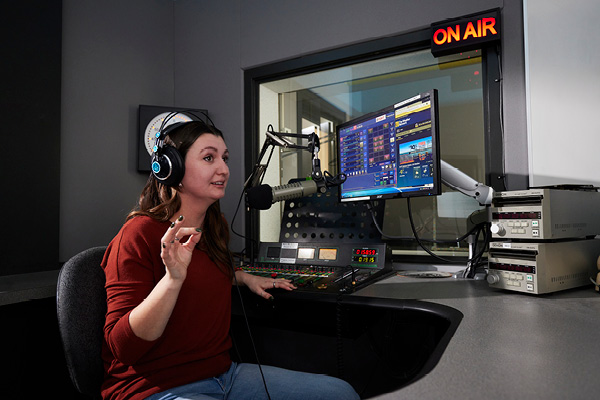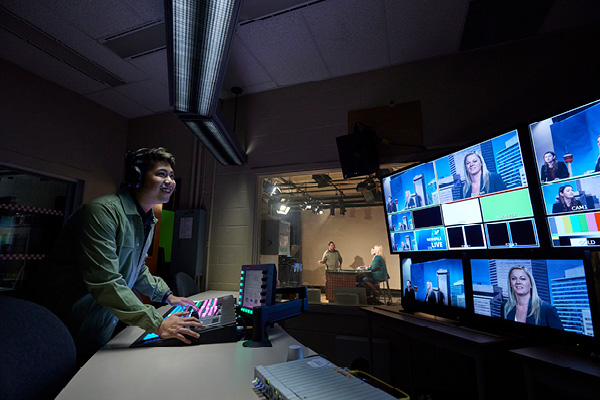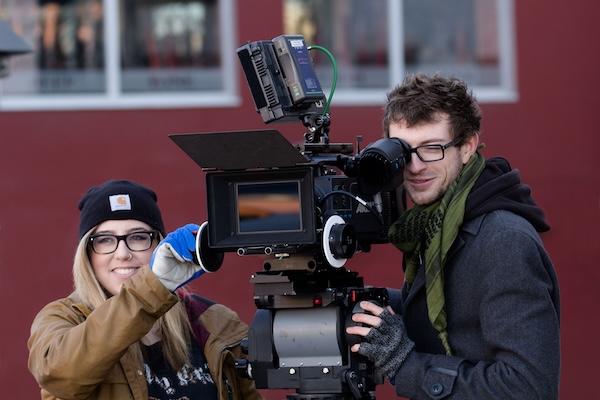On this page:
Overview
Are you the kind of person who constantly finds themselves immersed in YouTube videos, binge-watching TV shows, or creating captivating content for social media? If so, the Television major within the Radio, Television, and Broadcast News program is the perfect path for you to turn your passion for visual storytelling into a rewarding and exciting career.
This program helps you harness the power of storytelling through television and digital media and prepares you for a dynamic and ever-evolving media landscape.
If you are passionate about storytelling and creating engaging content, this program will give you the tools and knowledge to craft compelling narratives that captivate audiences.
In this program, you will:
- get hands-on experience in simulated real-world production and broadcasting environments, including single-camera or multi-camera setups
- learn all facets of television production, including the fundamentals of producing, directing, editing, and shooting
- explore a diverse range of projects, including drama, music videos, and documentaries
- work collaboratively in teams to produce sports, Esports, news, and talk programs, gaining invaluable teamwork and leadership skills
- prepare to work with broadcast-quality equipment that includes HD cameras, stabilizers (Steadicam, Dolly, Jib Arm), switchers, digital audio consoles, graphics systems, servers, and computer-based editing systems.
Our Television major is a launch pad for many exciting career opportunities. You'll have the fundamentals to become a producer, director, or editor for television shows, films, documentaries, or news programs.
Pursue a career in news reporting, journalism, or investigative reporting, or explore roles in media management, including content curation, scheduling, and programming for television networks and digital platforms.
Or, use your skills to create engaging content for social media platforms, streaming services, and online channels or enter the thrilling world of sports and Esports broadcasting, covering live events and providing commentary.
This program involves two years of full-time study, along with an industry practicum in your fourth semester.
If you're ready to turn your passion for visual storytelling into a successful and fulfilling career, this program is your gateway to media and entertainment.
Those in broadcasting are innovative, social, and methodical.
You need:
- curiosity
- initiative, persistence, and resourcefulness
- objectivity and integrity
- creativity
- an accurate memory
- communication and interview skills
- composure and poise
- research and critical thinking skills
- physical and emotional stamina to cope with the pressures of competitive, fast-paced work
- solid news judgment
- an interest in people and current events.
You should enjoy finding different ways to tell stories, working with many different people, generating interest from others, and methodically compiling information.
In your second year, you'll complete a two- to three-week practicum placement with an approved media-related employer.
Upon successfully completing this program, you'll receive a SAIT Radio, Television and Broadcast News diploma with a major in Television.
Careers and opportunities
Each year, SAIT conducts a survey between February and April to determine the employment rate, salary and satisfaction of our newest SAIT alumni.
![]() 75% graduate employment rate
75% graduate employment rate
Find out more about our graduate employment statistics >
Our graduates may work in the following occupations. Some careers require additional experience and education.
Associated National Occupational Classification (NOC) codes: 50011, 51120, 52110, 52112, 52113, 52114, 52119, 53111.

Career planning support
Unsure which career path is for you? Here are some recommended career planning resources to help you decide your future.
You can also head to Alberta alis for lots of information about careers in Alberta, including quizzes and labour market information to help you narrow down a path.
Finally, you can take our online career finder quiz, which can help narrow your options based on your current skills and interests.
Courses
The Radio, Television and Broadcast News - Television diploma requires 60 credits (21 courses) to complete.
The program spans two years, with two semesters each year.
You must take all of the following courses to complete this program.
General core
| Course | Credits |
|---|---|
|
This course is an introduction to computer fundamentals with emphasis on skills training. Theoretical components include Internet technology and terminology. Practical skills include file management, basic skills in word processing, spreadsheet applications, and presentation applications. Web applications and webpage design skills will be developed. |
1.5 |
|
The focus of this course is to develop and assess the writing skills essential for the broadcast industry. Topics include scriptwriting fundamentals, grammar, styles, script formats, research, and development of interview questions. |
3 |
|
This course provides emerging and existing leaders the opportunity to explore the concept of leadership and to develop and improve their leadership skills. The participant gains an understanding of leadership, articulates a personal philosophy of leadership, and applies various leadership skills. Involvement is accomplished through assigned readings, discussion, role playing, experiential activity, use of multimedia, journal writing, and extracurricular project and leader shadowing. |
1.5 |
|
Audio Video Production introduces learners to the basic tools and techniques of audio and video production. Learners develop production skills, forming the basis for advanced Radio, Television, and Broadcast News program elements. Through practical experience, learners explore digital audio production, audio/video editing, interview production, camera composition, single camera production techniques, and visual storytelling production and planning. Equivalents:
|
3 |
|
Creative expression and the concepts of dramatic, mental and physical involvement in performance are key elements to a future broadcasting career. Students study the foundational elements of improvisation, movement, dramatic interpretation, voice production, articulation, enunciation and public speaking. |
3 |
Television major core
| Course | Credits |
|---|---|
|
This course emphasizes the principles of project management necessary to produce broadcast-quality programming. The level of production value however, will be close to, if not ready for network television or a specialty service. Students learn how to apply for grants and set up a production company. Pre-requisites:
Corequsites:
|
6 |
|
In this course the student will complete two distinct elements. Students will plan and execute an individual or small group project of their choice that demonstrates their applied learning. Further, students will research and complete a 2-3 week practicum placement with an approved media related employer. Pre-requisites:
Corequsites:
|
1.5 |
|
Equipment requirements, operational techniques and artistic elements involved in producing a basic television program form the basis of the Introduction to Television Production course. The focus is on the traditional multi-camera or studio format. Following lectures and demonstrations, students have the opportunity to apply new techniques and disciplines in the production of short interview programs. |
3 |
|
The course is an introduction to the fundamentals of producing for television. Areas of exploration include: production schedules, budgets and grant applications. Students apply this learning in preparation for a variety of in-class productions. Pre-requisites:
Equivalents:
|
3 |
|
The course is an introduction to the fundamentals of producing for television. Areas of exploration include: production schedules, budgets and grant applications. Students apply this learning in preparation for a variety of in-class productions. Pre-requisites:
|
3 |
|
This is a more advanced exploration of the creative and technical side of editing. Through lectures and practical based lab sessions, students use digital tools, technologies and resources to complement the foundations established in the first semester. Pre-requisites:
Equivalents:
|
3 |
|
This course is a continuation in the development of television production skills and techniques. Learners complete exercises in a wide variety of production based elements in areas that include entertainment, interviews, and news. Pre-requisites:
|
3 |
|
This course covers the development of advanced studio and field television production skills and techniques. Students will take part in the production of live television debate shows, dramatic shorts, television shows, live sports events and newscasts. Pre-requisites:
|
3 |
|
This course provides the student with more advanced concepts and skills required to produce broadcast programs. These programs may include such things as: panel shows, magazine style programs, short dramatic productions and/or corporate style projects. You will also produce and direct live event programming and participate in directing newscasts. Pre-requisites:
|
3 |
|
In this course students apply advanced video and audio post-production techniques to complete packages. Students gain proficiency in using an advanced non-linear editing system and audio dedicated software. Students will build projects starting from raw footage to polished, exported deliverables for broadcast. Pre-requisites:
|
3 |
|
This course continues your progression into advanced EFP/ENG video field production techniques. The student will focus on advanced production gear, camera operation, shooting, lighting, and audio. Students use these skills and techniques in a variety of ENG/EFP production programming. Pre-requisites:
|
3 |
|
Students develop the post production skills necessary for entry level positions in the Television Industry. You will learn to integrate graphic design and video to enhance storytelling in your productions and improve your self-reflection and critique skills. Working in a simulated environment students learn collaboration with multiple editors and adherence to timelines. You will create video composites and build a portfolio of completed audio and visual works. Pre-requisites:
|
3 |
|
In this course students continue to develop proficiency in field production of broadcast programming. This includes ENG news programing, commercial production, and television show production. Students will learn to critique and evaluate field production against industry expectations. Pre-requisites:
|
3 |
|
This course introduces students to the various forms and potential jobs as writers in the television/media industry. Students will write a variety of scripts, from corporate and commercial to creative/fictional works, learn about the dedication and planning it takes to build creative material before beginning to write, and learn how to pitch ideas verbally and on paper to potential television industry professionals. The course also focuses on advertising both online and through conventional channels and on how to write commercials, PSA's, and specialized advertising for the internet. Pre-requisites:
Equivalents:
|
3 |
|
This course continues the study of writing for television. Techniques and procedures to move a script into production are introduced. Students explore critical analysis, and experience the roles of writers and showrunners within a writer's room. Pre-requisites:
|
3 |
|
In this course, students continue to study writing for television. Students hone skills as a story editor, pitch projects and create effective writing samples for industry. Processes and requirements for grant applications are discussed. Pre-requisites:
Corequsites:
|
1.5 |
Progression
You must attain a PGPA and/or a CGPA of 2.0 or better each semester and pass the prerequisite courses to progress through the program.
To qualify for graduation, you must pass all courses, attain a CGPA of 2.0 or better and complete course requirements within the prescribed timelines.
Review our grading and progression procedure >

Explore your options!
Some courses in this program are available through Open Studies. You can complete courses via Open Studies to get a head start on your education, reduce your course load once accepted into a credentialed program, or determine which career path best suits you before you fully commit.
You may also take courses for general interest or personal and professional development.
Admission requirements
Applicants educated in Canada
Applicants must demonstrate English language proficiency and meet all the following requirements or equivalents:
- at least 60% in English Language Arts 30-1 or 30-2.
SAIT accepts high school course equivalents for admission for applicants educated outside Alberta.
All applicants who were educated outside of Canada must demonstrate English language proficiency and provide proof they meet the program admission requirements outlined above with an international document assessment. Find accepted educational documents and assessment options.
SAIT may also accept courses completed at certain international post-secondary institutions.

Academic Upgrading
Missing an admission requirement for this program? Upgrade your prior education to help you receive admission into one of SAIT's career programs.
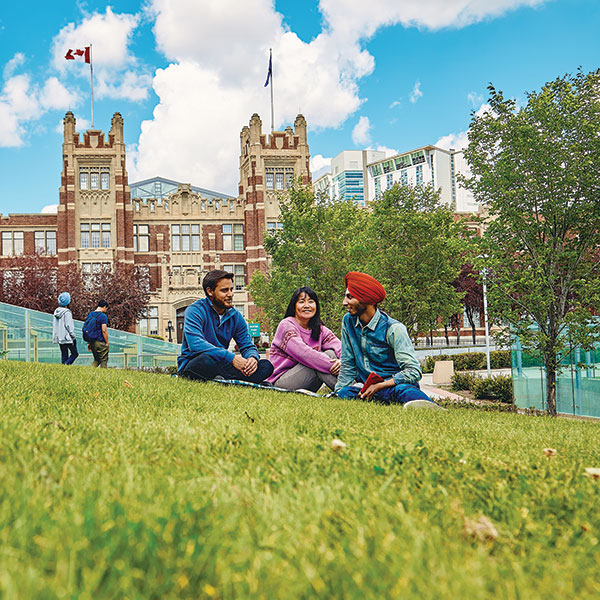
English language proficiency
All applicants must demonstrate English language proficiency prior to admission, including students educated in Canada.
Transfer agreements
At SAIT, we evaluate post-secondary credit you have previously earned and apply it to your SAIT credential. Explore our formal transfer agreements available for this program.
We can evaluate your prior education, even if we don't have a formal agreement in place.
Submit a transfer credit application
There are no formal transfer agreements currently in place for this program.
Transfer options for graduates
Build on the knowledge you’ve learned at SAIT. The opportunity to advance your education at an accredited post-secondary institution may be available.
🔗 Visit Transfer Alberta search tool for all transfer agreements in Alberta (including UCalgary, MRU and BVC).
If there are transfer agreements with other institutions outside of Alberta, nationally or internationally, they will be listed below.
Available intakes
Fall 2025
Start dates:
- Domestic students: Waitlisted
-
-
Application deadline: June 30, 2025
-
- International students: Open
-
-
Application deadline: May 30, 2025
-
Costs
2025/26 tuition and fees
The following estimated costs are effective as of July 1, 2025.
The estimated total cost of tuition and fees is based on the suggested schedule of study. Following a modified schedule will impact the fees you pay per semester and may alter final costs.
Domestic students
The program total is based on the estimated amount you will pay if you enter this program during the 2025/26 academic year. The program total amount listed on your letter of admission may appear higher. This amount is your maximum tuition guarantee for the program. SAIT will not exceed this maximum, regardless of changes in tuition and fees between academic years.
Books and supplies are approximately $1,000 - $1,500 per full-time year.
This is a bring-your-own-device program with a standard computer hardware and software requirement. See the specific requirements on our computers and laptops page.
Find your booklist on the SAIT Bookstore's website. The booklist will be available closer to the program start date. Can't find your program or course? The bookstore didn't receive a textbook list. Contact your program directly to determine if they're still refining course details or if you're in luck; no textbook purchase is required this term.

Financial aid
Paying for your education may feel overwhelming, but we have resources and programs that can help, including information about payment options, student loans, grants and scholarships.
Application process
When applying in the application portal, select Radio, Television and Broadcast News. You will be able to select Television as your major during the application process.
Ready to apply?
Follow our step-by-step guide to submitting a successful application.
Communication during admission
Email is the primary source of communication during the selection process. Ensure your personal email account is managed appropriately to receive our emails, files and communications. We recommend you add the sadt.advising@sait.ca domain to your safe senders' list or you risk missing critical email messages.
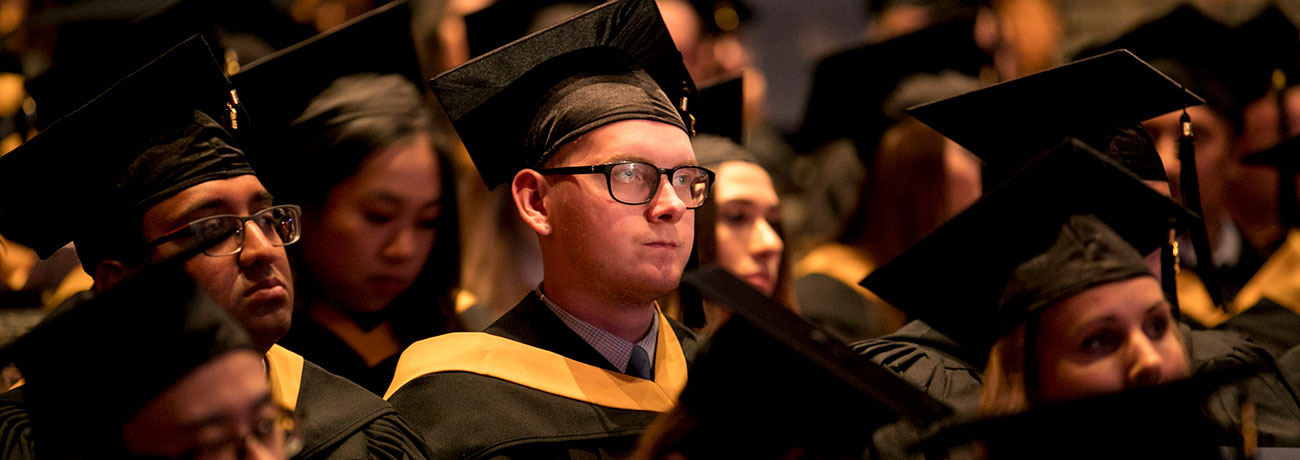
Begin your application
Apply now using the online application portal.
Ensure you have a valid Visa or Mastercard to pay the non-refundable application fee of $120 for domestic applicants or $175 for international applicants.
Information sessions
Prepare for a strong start in your chosen program or get the details you need to decide your future path.
Our expert staff and faculty are ready to answer your questions and provide information about the following:
- What sets SAIT apart
- An introduction to the program and area of study
- Admission requirements
- Future career paths
- Information on the earning potential and graduate employment rates.
Contact us
School for Advanced Digital Technology Advising
-
Phone - 403.284.8543
-
Email - sadt.advising@sait.ca
International Student Advising
-
Phone - 403.284.8852
-
Email - international@sait.ca
Subscribe for updates
Your journey starts here! Sign up to get important updates on:
- Graphic and media arts programs
- Application information
- Relevant news and events

Oki, Âba wathtech, Danit'ada, Tawnshi, Hello.
SAIT is located on the traditional territories of the Niitsitapi (Blackfoot) and the people of Treaty 7 which includes the Siksika, the Piikani, the Kainai, the Tsuut’ina and the Îyârhe Nakoda of Bearspaw, Chiniki and Goodstoney.
We are situated in an area the Blackfoot tribes traditionally called Moh’kinsstis, where the Bow River meets the Elbow River. We now call it the city of Calgary, which is also home to the Métis Nation of Alberta.

